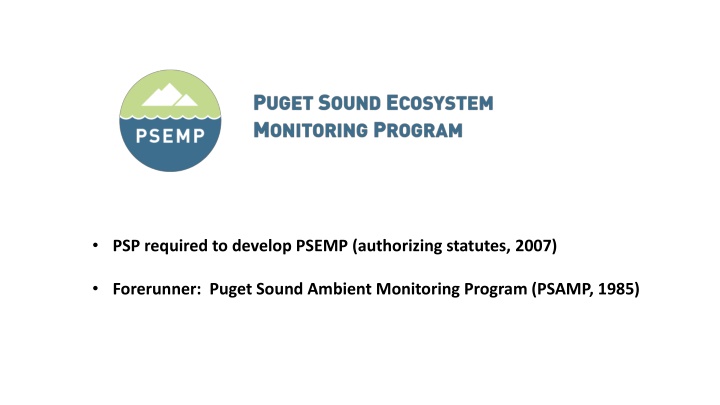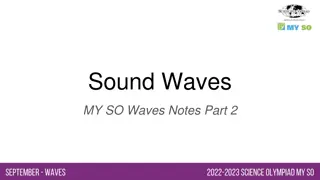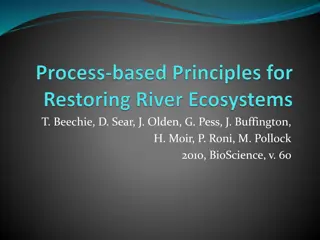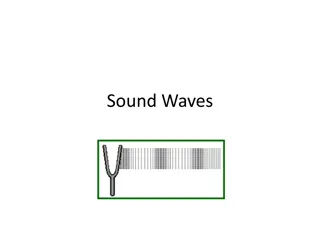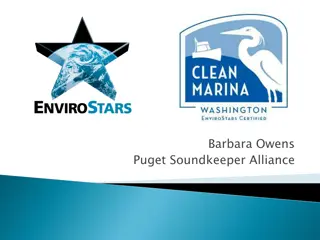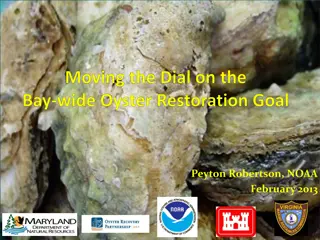Puget Sound Ecosystem Monitoring Program: Advancing Restoration Efforts
Puget Sound Ecosystem Monitoring Program (PSEMP) was established to coordinate ecosystem monitoring and assessment activities across Puget Sound basin. It aims to support decision-making, answer critical questions about ecosystem health, and enhance collaboration among stakeholders. PSEMP's objectives include assessing ecosystem status, supporting recovery efforts, and ensuring credible data dissemination. Recent reviews have led to revised structures and objectives to strengthen its mission further.
Uploaded on Feb 23, 2025 | 2 Views
Download Presentation

Please find below an Image/Link to download the presentation.
The content on the website is provided AS IS for your information and personal use only. It may not be sold, licensed, or shared on other websites without obtaining consent from the author.If you encounter any issues during the download, it is possible that the publisher has removed the file from their server.
You are allowed to download the files provided on this website for personal or commercial use, subject to the condition that they are used lawfully. All files are the property of their respective owners.
The content on the website is provided AS IS for your information and personal use only. It may not be sold, licensed, or shared on other websites without obtaining consent from the author.
E N D
Presentation Transcript
PSP required to develop PSEMP (authorizing statutes, 2007) Forerunner: Puget Sound Ambient Monitoring Program (PSAMP, 1985)
Puget Sound Ecosystem Monitoring Program (PSEMP) -- Established by PSP Leadership Council in 2011 as a coordinated ecosystem monitoring and assessment program -- To serve the needs of the PSP and the many organizations and entities across the Puget Sound basin that are committed to helping the PSP through their individual and collective actions achieve the goal of restoring and protecting the health of Puget Sound -- PSEMP Charter approved by PSP (2011) -- Biennial PSEMP workplans -- Guidance for monitoring workgroups -- Funding strategy (2014) -- Monitoring Inventories and Gaps analysis -- Communication and information sharing (reports, forums, conferences)
PSEMP Objectives (2011) 1. Answer questions about (a) the status of the ecosystem and progress toward ecosystem recovery and (b) the effectiveness of restoration and protection actions 2. Support decision making (by the Puget Sound Partnership and other organizations) about recovery efforts and their adaptation by ensuring that monitoring and assessment findings (data, results, and conclusions) are (a) credible and trusted with known precision, accuracy, and (b) provided to decision-makers and broad audience of partners and stakeholders. 3. Work in a collaborative, transparent fashion to coordinate and integrate monitoring programs across Puget Sound and the rest of the Salish Sea as a system of data collection and evaluation that is efficient and effective for all partners.
Recent Reviews of PSEMP: 2014 Ruckelshaus Center evaluation 2016 JLARC Audit (as part of PSP review) 2018 PSP response to Governor & JLARC 2019 Revised PSEMP structure, objectives & workplans PSEMP website: https://sites.google.com/a/psemp.org/psemp/
Revised PSEMP Mission & Objectives (2018) Mission: Convene a collaborative network of subject matter experts who organize, synthesize, and communicate scientific information from many monitoring organizations and different parts of the ecosystem to directly address foundational management and science questions critical to recovery of the ecosystem. 1. Create and maintain forums to increase collaboration across monitoring programs to improve effectiveness and efficiency of monitoring programs and their ability to meet the information needs of planners, managers, and decision-makers. Organize and synthesize the data being gathered by existing monitoring programs to increase access to available information, and highlight priority knowledge gaps to be filled. 2. Support adaptive management of recovery efforts by: evaluating the effectiveness of recovery actions and approaches so that those actions can be prioritized; engaging PSEMP members in planning processes such as Implementation Strategies (Figure 3); and facilitating the exchange of knowledge among PSEMP members and with planners, managers, and decision-makers (Figure 2). 3. Improve communication within the monitoring and assessment community and to audiences specified in a new communications plan in order to improve access to and use of credible information in decisions about Puget Sound recovery efforts.
Puget Sound Ecosystem Monitoring Program Strategic Plan 2018-2022 * PSEMP is unique and effective because of its coordinated network structure that harnesses commitment across geographies and organizations to improve efficiency of monitoring to inform the Puget Sound recovery effort. * This Strategic Plan articulates a renewed mission for PSEMP to convene a collaborative network of subject matter experts who organize, synthesize, and communicate scientific information from many monitoring organizations and different parts of the ecosystem to directly address foundational management and science questions critical to recovery of the ecosystem. * PSEMP spans the boundary between science and decision-making to facilitate the exchange of knowledge among monitoring programs, the Partnership and its boards system, and others working to advance Puget Sound recovery. * Scientific evidence and syntheses vetted through PSEMP are used broadly to guide decisions and inform policies about Puget Sound recovery at local and regional scales. * The Partnership submitted a funding request to the Governor and Legislature, for the 2019-2021 biennium, to put this plan in motion, and meet a growing need for timely, relevant, and credible information that directly links scientific findings to management decisions. * This plan will be reviewed biennially and updated in four years, and yearly work plans for the Steering Committee and work groups will enable adaptive management at a fine scale, to reach the objectives of this plan.
PSEMP Steering Committee is composed of stakeholders from: Local (Pierce Co., King Co.) State (ECY, DNR, SRO, WDFW) Federal (EPA, NOAA, USGS) Tribes (NWIFC) Academia (UW, Sea Grant, PSI, WWU) PSP Science Panel Citizen Science (vacant) Environmental organizations (Audubon, DERT) Local Integrating Organizations (vacant) Watersheds (vacant) Business & Consultants (vacant)
